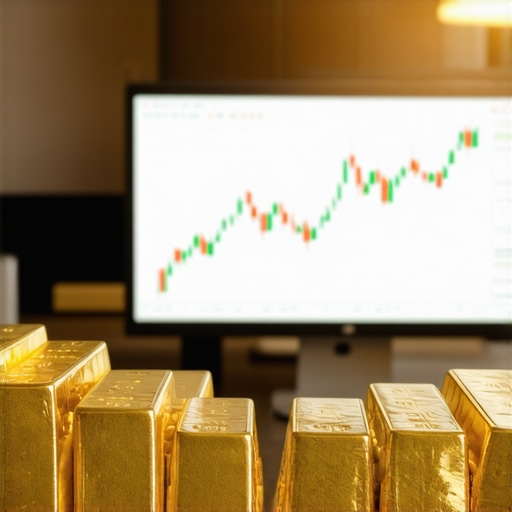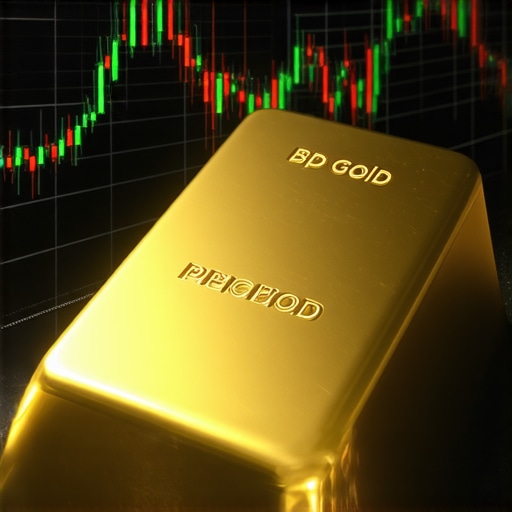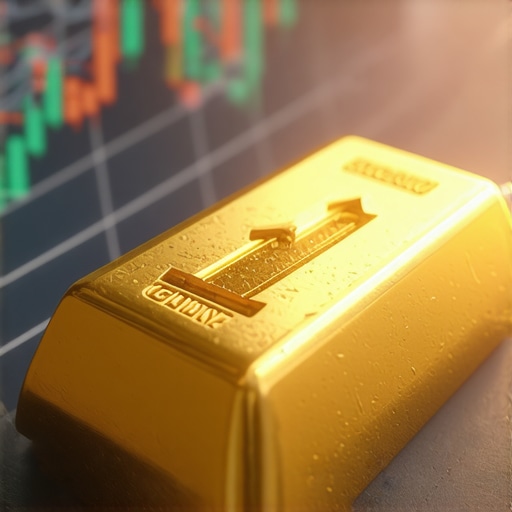Unlocking the Secrets Behind Gold Price Movements for 2026
In an era marked by economic fluctuations and geopolitical uncertainties, gold continues to shine as a timeless refuge for savvy investors. Yet, planning your 2026 investments with precision requires more than just blind faith in gold’s historical stability — it demands an expert understanding of effective gold price forecasts. This article delves deeply into the nuanced factors influencing gold prices, offering you a sophisticated compass to navigate the complex landscape ahead.
Decoding Complex Market Dynamics: Beyond Surface-Level Predictions
Gold prices are influenced by a matrix of interconnected drivers ranging from global monetary policies, inflation trends, currency fluctuations, to geopolitical tensions. For instance, the Federal Reserve’s interest rate decisions in 2025 are expected to reverberate into 2026, often inversely affecting gold’s appeal as a non-yielding asset. Additionally, rising inflationary pressures, particularly in emerging markets, historically propel gold prices upward as investors seek to preserve purchasing power. Recognizing these patterns empowers investors to anticipate price movements more effectively.
How Do Global Demand Trends Shape Accurate Gold Price Forecasts?
Understanding global gold demand is pivotal for precise forecasting. The growing appetite for physical gold in Asia, particularly India and China, alongside increased central bank purchases worldwide, underpins bullish expectations for gold in 2026. This surge in demand, juxtaposed with constrained supply due to mining limitations, creates an upward pressure on prices. According to the World Gold Council’s latest report, central banks acquired more than 700 tonnes of gold in 2023, signaling sustained institutional interest that forecasts predict will continue robustly into 2026 (World Gold Council).
Leveraging Advanced Forecasting Models: The Investor’s Edge
Modern investors benefit from sophisticated forecasting tools that integrate machine learning algorithms analyzing historical price data with macroeconomic indicators. These models can detect subtle market signals and volatility patterns that traditional methods may overlook. Incorporating geopolitical risk indices alongside supply-demand analytics, these forecasts deliver a layered perspective, crucial for tactical asset allocation.
Practical Application: Crafting Investment Strategies Around Forecast Insights
Effectively planning your 2026 gold investments means aligning your portfolio with forecast insights tailored to your risk appetite. For example, diversifying exposure through gold ETFs or mutual funds can mitigate volatility while capturing upside potential, a strategy supported by numerous experts in consistent return gold investment vehicles. For those inclined towards physical assets, understanding demand trends and supply constraints aids in timing purchases of bullion or coins strategically, as recommended in safe physical gold investment guides.
Anticipating Market Volatility: The Role of Gold as a Defensive Asset
Gold’s reputation as a hedge against economic uncertainty remains unchallenged, but its performance during varying market volatilities requires nuanced interpretation. Forecasts suggest that in a scenario of rising inflation coupled with geopolitical unrest, gold prices could experience notable spikes. Conversely, in a stable economic environment with rising interest rates, growth may be more subdued. These insights enable investors to adjust their exposure dynamically, preserving wealth while capitalizing on market swings.
Join the Conversation: How Are You Planning Your Gold Investments for 2026?
We invite you to share your strategies or questions in the comments below. Engaging with a community of informed investors enhances collective understanding and helps refine your approach.
For a deeper dive into gold investment strategies and market trends, explore our comprehensive resources like Effective Gold Investment Strategies to Grow Your Wealth in 2025.
Integrating Geopolitical Risk Analysis for Sharper Gold Market Predictions
While economic indicators remain critical, the increasing geopolitical tensions worldwide add layers of complexity to gold price forecasts. Conflicts, trade disputes, and regulatory shifts can trigger rapid shifts in investor sentiment, often sending gold prices soaring as a safe haven. For example, the ongoing trade frictions between major economies or unexpected geopolitical events can disrupt supply chains and increase uncertainty, which historically has led to increased demand for gold. Incorporating geopolitical risk indices into forecasting models thus enhances the predictive accuracy, allowing investors to anticipate sudden market adjustments and adjust portfolios proactively.
Understanding the Impact of Technological Advancements on Gold Supply
Technological innovations in mining and recycling are subtly reshaping the gold supply landscape. Advanced extraction techniques and increased efficiency in gold recycling can offset some supply constraints, influencing gold’s availability and price. However, these developments are often gradual and localized, so their impact on the global supply-demand balance requires careful assessment. Investors monitoring these trends can gain an informational edge, particularly when combined with demand analysis from emerging markets.
What Are the Emerging Indicators Investors Should Monitor for 2026 Gold Price Movements?
Beyond traditional factors, emerging indicators such as central bank digital currency policies, shifts in global energy prices, and environmental regulations affecting mining operations are becoming crucial. For instance, stricter sustainability requirements could raise operational costs for mining companies, tightening supply and pushing prices upward. Likewise, fluctuations in energy costs directly affect mining expenses, indirectly impacting gold availability. Monitoring these subtle yet influential indicators allows investors to refine their forecasts and optimize entry and exit points in gold investments.
For a comprehensive understanding of these evolving dynamics, readers can explore detailed analyses at the World Gold Council, which provides authoritative data and insights grounded in rigorous research.
Strategic Portfolio Adjustments: Balancing Gold with Complementary Assets
Incorporating gold into diversified portfolios demands strategic balancing with other asset classes to maximize risk-adjusted returns. For example, pairing gold with inflation-protected bonds or select mining stocks can enhance portfolio resilience amid economic turbulence. Investors may also consider tactical allocations to gold futures or ETFs as flexible instruments to capture short-term opportunities while maintaining long-term exposure. Insights from experts recommend continuous portfolio rebalancing based on updated forecasts and market signals, a practice that mitigates downside risks and exploits gold’s defensive characteristics effectively.
To deepen your strategy development, reviewing resources like Gold vs Stocks: Smart Portfolio Allocation Tips can offer actionable guidance for nuanced asset allocation in 2026.
Risk Management Nuances: Navigating Gold Market Volatility
Gold’s allure as a stable asset sometimes masks its inherent volatility, especially in reaction to sudden macroeconomic shifts or speculative trading. Sophisticated investors employ risk management techniques such as stop-loss orders, option hedging, and volatility tracking to safeguard capital. Understanding the behavioral patterns of gold price spikes and dips, often amplified by geopolitical news or monetary policy surprises, is critical. These techniques help maintain portfolio stability while allowing for capitalizing on gold price rallies.
Join the Expert Dialogue: How Will Emerging Global Trends Influence Your 2026 Gold Investment Approach?
We encourage you to share your perspectives and questions to foster a robust investment community dialogue. Engaging with peers and experts sharpens investment acumen and uncovers diverse strategies. Additionally, consider expanding your knowledge by visiting How Global Gold Demand Trends Are Shaping Investment Strategies for further expert insights and data-driven analysis.
Harnessing Macro-Financial Indicators for Superior Gold Price Projections
Beyond geopolitical and supply-demand fundamentals, a deeper dive into macro-financial indicators reveals nuanced signals that can refine gold price forecasts for 2026. Metrics such as real interest rates, Treasury yield curves, and global liquidity conditions provide essential context for gold’s trajectory. For example, negative real interest rates historically bolster gold’s appeal since the opportunity cost of holding non-yielding assets diminishes. The inverted yield curves observed in late 2025 could foreshadow economic slowdown, potentially increasing gold’s safe-haven demand. Furthermore, global central bank liquidity injections or contractions influence investment flows into gold markets, with quantitative easing typically supporting higher prices.
How Do Real Interest Rates and Monetary Policy Interact to Influence Gold Prices?
Real interest rates, defined as nominal interest rates adjusted for inflation, serve as a critical barometer for gold prices. When central banks implement accommodative monetary policies to stimulate growth, nominal rates often fall below inflation rates, resulting in negative real yields. This environment reduces the attractiveness of interest-bearing assets relative to gold. Conversely, tightening policies with rising real yields can suppress gold investment demand. The intricate dance between these forces requires investors to monitor central bank communications and inflation data meticulously to anticipate gold price inflections. The Federal Reserve’s minutes and inflation expectations derived from Treasury Inflation-Protected Securities (TIPS) spreads are invaluable data points in this analysis (Federal Reserve Monetary Policy).
Deciphering the Role of Emerging Market Currency Fluctuations in Gold Valuation
Emerging market currencies, particularly those of key gold consumers like India, China, and Turkey, exert significant influence on gold prices. Currency depreciation in these regions typically escalates local gold demand as investors seek protection against weakening domestic purchasing power. Moreover, fluctuations can impact import costs, altering demand elasticity. For 2026, geopolitical tensions and domestic monetary policies in these economies might induce volatility, thereby creating complex feedback loops affecting gold’s global price. Sophisticated investors track currency futures alongside gold futures to identify arbitrage opportunities and hedge risks effectively.
Incorporating Environmental, Social, and Governance (ESG) Factors into Gold Investment Strategies
The growing emphasis on ESG criteria is reshaping the gold mining industry’s operational landscape, with significant implications for supply-side dynamics. Stricter environmental regulations, community engagement standards, and labor practices can increase production costs and delay project timelines, tightening supply. Investors increasingly favor mining companies demonstrating robust ESG compliance, which can translate to premium valuations and more stable returns. Integrating ESG analytics into forecasting models offers a forward-looking perspective on supply constraints and reputational risks, enhancing strategic asset selection.
What Advanced Quantitative Techniques Are Enhancing Gold Price Prediction Accuracy?
Cutting-edge quantitative methods such as ensemble machine learning, sentiment analysis from financial news, and real-time alternative data streams — including satellite imagery of mining activity and social media trends — are elevating gold price prediction sophistication. Ensemble models combine multiple algorithms to improve robustness, while sentiment analysis captures market psychology shifts that precede price movements. These innovations complement traditional econometric approaches, offering investors a multi-dimensional toolkit to navigate increasingly complex gold markets. For an in-depth exploration of these techniques, consult the recent research published in the Journal of Quantitative Finance.
To stay ahead in 2026’s dynamic gold investment landscape, deepen your expertise by leveraging these advanced analytical frameworks and engage with expert community discussions to refine your strategies continuously.
Decoding Macro-Financial Signals for Enhanced Gold Price Forecasting
In the labyrinthine world of gold investment, discerning the subtle interplay between macro-financial indicators and gold pricing dynamics is paramount. Investors must scrutinize real interest rates, Treasury yield curve configurations, and global liquidity conditions to anticipate gold’s trajectory with greater precision. Notably, environments characterized by negative real yields—where inflation outpaces nominal interest rates—amplify gold’s attractiveness due to the diminished opportunity cost of holding non-yielding assets. The inverted yield curves observed in late 2025, signaling potential economic deceleration, further accentuate gold’s safe-haven appeal, positioning it as a strategic asset amid uncertainty.
Emerging Market Currency Volatility: A Crucible for Gold Valuation Shifts
Currency fluctuations in emerging economies, particularly India, China, and Turkey, wield considerable influence over gold’s demand and valuation. Depreciation of these currencies typically catalyzes heightened local gold purchases as investors seek a bulwark against eroding purchasing power. This dynamic not only affects import costs but also modulates demand elasticity, engendering complex feedback loops that reverberate through global gold pricing. Astute investors leverage currency futures and gold derivatives in tandem to exploit arbitrage prospects and hedge geopolitical and monetary policy risks inherent in these volatile markets.
Elevating Investment Strategies Through ESG Integration in Gold Mining
The ascendancy of Environmental, Social, and Governance (ESG) criteria is reshaping the gold mining sector’s operational and financial landscape. Heightened environmental regulations, community engagement mandates, and labor standards are escalating production costs and elongating project timelines, thereby exerting upward pressure on supply constraints. Concurrently, mining enterprises with exemplary ESG practices command valuation premiums and tend toward more sustainable returns. Investors embedding ESG analytics into their forecasting and asset selection frameworks gain a prognostic edge, aligning capital deployment with evolving regulatory and societal expectations.
Which Advanced Quantitative Techniques Are Revolutionizing Gold Price Prediction?
Leveraging avant-garde quantitative methodologies is increasingly central to refining gold price forecasts. Ensemble machine learning models synthesize diverse algorithmic insights to heighten predictive robustness, while sentiment analysis of financial news and social media captures the market’s psychological undercurrents preceding price inflections. Additionally, real-time alternative data streams—such as satellite imagery monitoring mining activity—offer unprecedented granularity and immediacy. This multi-dimensional analytical arsenal complements conventional econometric models, empowering investors with superior foresight in an ever-complex gold market environment. For an authoritative exploration of these sophisticated techniques, consult the Journal of Quantitative Finance.
To fortify your 2026 gold investment acumen, integrating these advanced analytical frameworks and engaging with expert discourse will prove invaluable.
Invitation to Engage: How Will You Leverage Emerging Gold Market Insights in 2026?
We encourage you to contribute your expert perspectives and strategic approaches in the evolving gold investment dialogue. Sharing insights fosters collective intelligence and sharpens individual decision-making amid the multifaceted market forces at play. Dive deeper into these advanced topics and continue refining your investment strategy with our curated resources and community exchanges.

Frequently Asked Questions (FAQ)
What are the primary factors influencing gold prices in 2026?
The main drivers include global monetary policy shifts, especially interest rate changes by central banks; inflationary trends; geopolitical tensions; supply constraints from mining and recycling; and demand dynamics from emerging markets like China and India. Additionally, emerging macro-financial indicators such as real interest rates, Treasury yield curves, and global liquidity also play critical roles.
How does inflation impact gold price movements?
Inflation erodes the purchasing power of fiat currencies, increasing gold’s appeal as a store of value. Historically, rising inflation, particularly when accompanied by negative real interest rates, tends to push gold prices higher as investors seek protection against currency depreciation.
Why is monitoring emerging market currencies important for gold investors?
Emerging market currencies, notably in large gold-consuming countries, influence local gold demand. Depreciation of these currencies often leads to increased gold purchases as a hedge against weakening purchasing power, which can in turn affect global gold prices through demand changes and import cost fluctuations.
What role do geopolitical risks play in gold price forecasting?
Geopolitical tensions such as conflicts, trade disputes, and regulatory uncertainties typically increase market volatility and investor risk aversion. Gold, as a safe-haven asset, often benefits from spikes in demand during such periods, making geopolitical risk analysis a crucial component of accurate gold price forecasts.
How are advanced forecasting models improving gold price predictions?
Modern forecasting integrates machine learning, ensemble models, sentiment analysis, and real-time alternative data such as satellite imagery and social media trends. These tools enhance prediction accuracy by capturing complex market signals, investor sentiment, and supply-demand nuances that traditional models might miss.
In what ways does ESG influence gold mining and prices?
Environmental, Social, and Governance (ESG) criteria are reshaping mining operations, often leading to higher production costs and slower project timelines due to stricter regulations and community standards. This can tighten gold supply and increase prices. Additionally, investors increasingly prefer mining companies with strong ESG profiles, impacting valuations and investment flows.
What risk management strategies are recommended for gold investors?
Risk management techniques include using stop-loss orders, option hedging, and volatility monitoring to protect against sudden price swings. Diversifying gold exposure across physical assets, ETFs, and futures also helps balance risk and returns.
How can investors strategically balance gold with other assets in their portfolios?
Combining gold with inflation-protected bonds, select mining stocks, or other defensive instruments can enhance portfolio resilience. Tactical adjustments based on updated forecasts and market signals allow investors to exploit gold’s safe haven benefits while managing overall risk.
What emerging indicators should investors track for 2026 gold price movements?
Key emerging indicators include central bank digital currency policies, global energy price fluctuations, environmental regulations affecting mining, and evolving macro-financial metrics such as liquidity conditions. Monitoring these helps anticipate supply-demand shifts and price volatility.
How do real interest rates interact with gold prices?
Real interest rates (nominal rates minus inflation) are inversely related to gold prices. Negative real rates reduce the opportunity cost of holding gold, boosting demand and prices. Conversely, rising real rates may suppress gold’s appeal as an investment.
Trusted External Sources
- World Gold Council: Provides authoritative data on global gold demand, supply trends, and market insights essential for understanding gold price drivers and investment strategies.
- Federal Reserve Monetary Policy Reports: Offers detailed information on interest rate decisions, inflation expectations, and economic outlooks critical for interpreting gold price movements relative to macroeconomic policies.
- Journal of Quantitative Finance: Features cutting-edge research on advanced forecasting models including machine learning and sentiment analysis that enhance gold price prediction accuracy.
- International Monetary Fund (IMF): Supplies global economic and financial data, including currency fluctuations and liquidity conditions that affect gold markets worldwide.
- Environmental, Social and Governance (ESG) Research Platforms: Specialized ESG analytics providers offer insights into regulatory impacts on gold mining operations influencing supply and investment valuations.
Conclusion: Mastering Gold Price Forecasting for Strategic 2026 Investments
As 2026 approaches, understanding the intricate web of factors shaping gold prices is indispensable for investors seeking to optimize returns and manage risks. From macro-financial signals like real interest rates and Treasury curves to geopolitical dynamics and emerging market currency volatilities, gold price forecasting demands a multi-dimensional analytical approach. Integrating advanced quantitative models, ESG considerations, and vigilant monitoring of supply-demand fundamentals empowers investors with a refined perspective to capitalize on gold’s unique defensive and growth attributes.
Strategic portfolio construction balancing gold with complementary assets, along with robust risk management techniques, ensures resilience amid volatility. By staying informed through trusted sources and engaging with expert discourse, investors can navigate the complexities of the gold market with confidence.
We invite you to share your insights, explore our related expert content, and apply these comprehensive strategies to your 2026 gold investments for sustained success.
Stay ahead of the curve—invest wisely, hedge smartly, and let gold illuminate your path forward.
#IMAGE_PLACEHOLDER_D#










